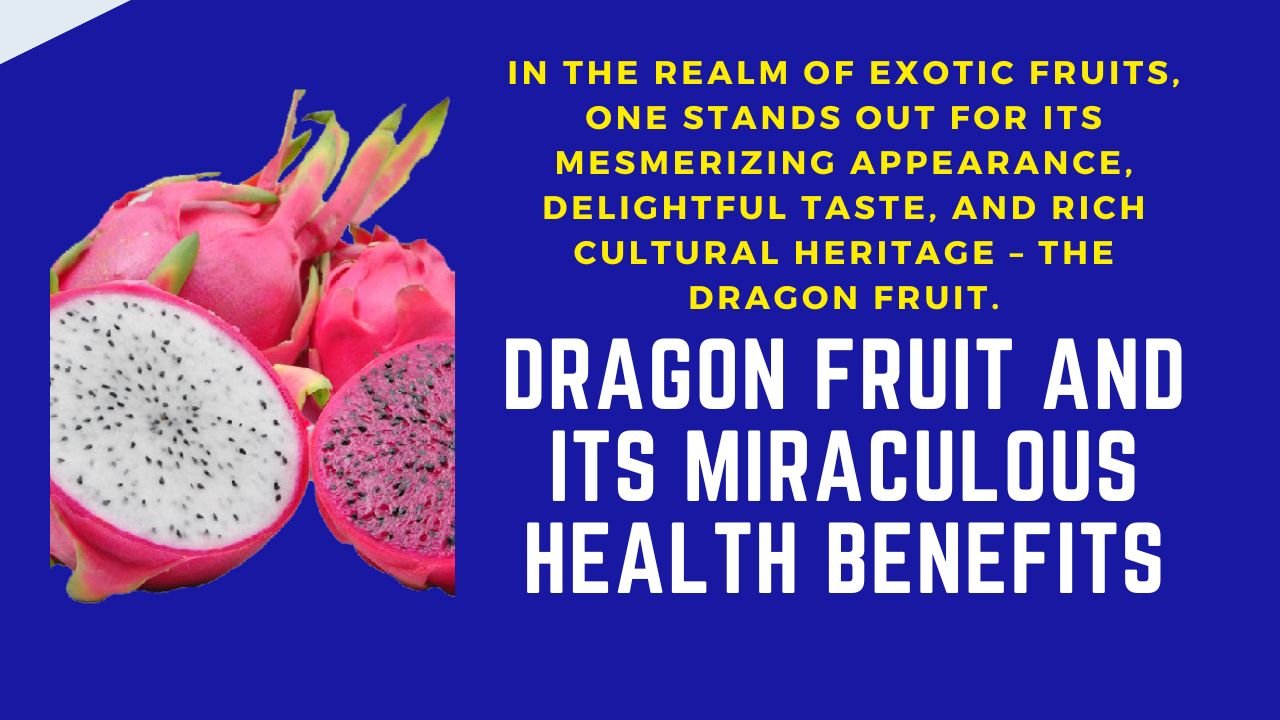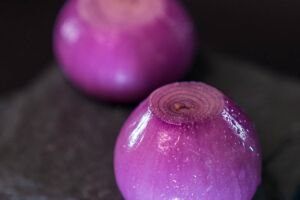Introduction:
In the realm of exotic fruits, one stands out for its mesmerizing appearance, delightful taste, and rich cultural heritage – the dragon fruit. With its vibrant hues, intriguing shape, and a flavor that dances between sweetness and subtlety, dragon fruit has captured the fascination of food enthusiasts and health-conscious individuals alike. In this blog post, we embark on an enthralling journey into the world of dragon fruit, unraveling its mysteries, exploring its origins, and discovering the myriad ways it tantalizes our senses.
Imagine biting into a fruit that not only delights your taste buds but also offers a wealth of nutrients, enhancing your well-being. Dragon fruit, also known as pitaya, pitahaya, or strawberry pear, has earned a reputation not only for its exceptional flavor but also for its numerous health benefits. From its beginnings in the tropical regions of Central America and Southeast Asia to its widespread cultivation across the globe, dragon fruit has woven itself into the tapestry of various cultures and traditions.
As we delve deeper, we will uncover the captivating tales surrounding dragon fruit, its nutritional secrets, and its versatile presence in kitchens worldwide. Join us as we explore the allure of this enchanting fruit, learning how it not only graces our palates but also adds a touch of exotic elegance to our culinary adventures. So, prepare to be enchanted and enlightened, as we embark on a fascinating odyssey into the vibrant world of dragon fruit.
What Is Dragon Fruit?

Dragon fruit, also known as pitaya or pitahaya, is a unique and visually stunning fruit that belongs to the cactus family. This exotic fruit is renowned for its vibrant appearance, characterized by bright pink or yellow skin and white or red flesh speckled with tiny black seeds. Its distinctive shape, often likened to a flame or a dragon’s scales, adds to its allure.
Appearance and Taste: The outer skin of dragon fruit is thick and leathery, typically in shades of pink, red, or yellow. The flesh inside can be white, red, or even purple, depending on the variety. The texture is often compared to a kiwi due to its small, crunchy black seeds. Dragon fruit has a mild, sweet flavor with hints of pear, kiwi, and watermelon, making it a refreshing and enjoyable treat.
Nutritional Profile: Dragon fruit is not only visually appealing but also packed with essential nutrients. It is a rich source of vitamins, especially vitamin C, as well as minerals like iron and magnesium. Additionally, dragon fruit is low in calories and contains beneficial antioxidants, making it a popular choice among health-conscious individuals.
Culinary Uses: Dragon fruit is incredibly versatile in the kitchen. It can be enjoyed on its own, added to fruit salads, or blended into smoothies. Chefs and home cooks often use dragon fruit to create visually stunning desserts, such as ice creams, sorbets, and cakes. Its subtle taste makes it a great addition to both sweet and savory dishes, offering a unique twist to various recipes.
Intriguing both in appearance and taste, dragon fruit continues to captivate food enthusiasts and chefs, not just for its aesthetic appeal but also for its delightful flavor and nutritional benefits. Whether enjoyed fresh or incorporated into creative culinary creations, dragon fruit remains a symbol of exotic indulgence in the world of fruits.
The Origin Story: Where Dragon Fruit Comes From
Originally native to Central America and parts of South America, dragon fruit is now cultivated in various tropical and subtropical regions worldwide. It thrives in countries such as Vietnam, Thailand, Malaysia, and the Philippines. There are several varieties of dragon fruit, each with its own subtle differences in taste, texture, and color.

Dragon fruit, with its dazzling appearance and intriguing name, has a rich and storied origin that spans continents and centuries. To truly appreciate this exotic fruit, we must embark on a journey back in time to explore where dragon fruit comes from.
Central and South America: The Birthplace of Dragon Fruit The dragon fruit, scientifically known as Hylocereus and Selenicereus, finds its roots in the lush landscapes of Central and South America. This region is often considered the cradle of dragon fruit, where it has thrived for thousands of years. Indigenous peoples of these areas, such as the Aztecs and the Maya, were among the first to cultivate and enjoy this succulent fruit.
Varieties and Adaptations: Diverse Origins within the Americas Within Central and South America, dragon fruit boasts several distinct varieties, each with its unique characteristics. The two primary species are Hylocereus undatus and Hylocereus costaricensis. The former, with its white flesh and pink skin, is perhaps the most recognized dragon fruit variety. Meanwhile, the latter exhibits red flesh and skin.
These varieties have adapted to diverse ecosystems, ranging from the rainforests of Central America to the arid desert regions of South America. This adaptability allowed dragon fruit to thrive in different climates, paving the way for its eventual spread to other parts of the world.
The Asian Connection: Dragon Fruit’s Journey to Southeast Asia While dragon fruit’s origins lie in the Americas, it eventually found its way to Southeast Asia, where it has become deeply entrenched in local agriculture and culture. The fruit’s migration to this region can be traced back to the 19th century, when European colonialists introduced it to Vietnam, Thailand, Malaysia, and the Philippines.
In Southeast Asia, dragon fruit took on new names, such as “pitaya” or “pitahaya,” reflecting its local assimilation. The climate and soil conditions in these countries proved ideal for dragon fruit cultivation, and it quickly became a staple crop.
Global Expansion: Dragon Fruit’s Worldwide Presence Today, dragon fruit is not limited to its original habitats in the Americas or its adopted homes in Southeast Asia. It has become a global sensation, with cultivation extending to countries in Europe, Africa, and beyond. This widespread popularity is due to the fruit’s adaptability and its ability to thrive in various climatic conditions.
A Fruit with a Rich Heritage The origin story of dragon fruit is a testament to its enduring appeal and adaptability. From its ancient beginnings in the heart of Central and South America to its far-reaching presence across the globe, dragon fruit has carved a unique place for itself in the world of exotic fruits. Its history is as colorful and diverse as its outer skin, making it a fruit worth celebrating and savoring for generations to come.
Dragon Fruit Nutrition Contents
Dragon fruit, with its stunning appearance and delightful taste, is not just a feast for the eyes and palate but also a nutritional powerhouse. Packed with essential vitamins, minerals, and antioxidants, this exotic fruit offers a range of health benefits. Here’s a closer look at the impressive nutritional contents of dragon fruit:
1. Vitamins:
- Vitamin C: Dragon fruit is exceptionally rich in vitamin C, a potent antioxidant that boosts the immune system, promotes healthy skin, and aids in wound healing.
- Vitamin B1 (Thiamine) and B3 (Niacin): These B-vitamins play a crucial role in energy metabolism, supporting the body’s conversion of food into usable energy.
2. Minerals:
- Calcium: Important for bone health, calcium is found in dragon fruit in moderate amounts.
- Iron: Dragon fruit contains iron, which is essential for the formation of red blood cells and the transport of oxygen in the body.
- Magnesium: This mineral supports muscle and nerve function, helps regulate blood sugar levels, and contributes to bone health.
- Phosphorus: Crucial for the formation and maintenance of healthy bones and teeth.
3. Dietary Fiber:
- Dragon fruit is a good source of dietary fiber, which aids in digestion, helps prevent constipation, and supports a healthy digestive system. Fiber also contributes to a feeling of fullness, making it beneficial for weight management.
4. Antioxidants:
- Dragon fruit is loaded with antioxidants, including betalains and flavonoids, which help neutralize harmful free radicals in the body. Antioxidants play a vital role in reducing the risk of chronic diseases and supporting overall well-being.
5. Hydration:
- Dragon fruit has a high water content, contributing to hydration and helping maintain the body’s fluid balance. Staying well-hydrated is essential for various bodily functions and overall health.
6. Low Calorie and Low Fat:
- Dragon fruit is naturally low in calories and fat, making it a healthy snack option for those watching their calorie intake.
7. Protein:
- While dragon fruit is not a significant source of protein, it does contain small amounts, contributing to the overall nutrient profile.
Incorporating dragon fruit into your diet provides a wealth of essential nutrients, making it a valuable addition to a balanced and healthy eating plan. Whether enjoyed on its own, added to smoothies, salads, or desserts, dragon fruit not only delights the taste buds but also nourishes the body, promoting optimal health and wellness.
10 Health Benefits Of Dragon Fruits
Dragon fruit, with its vibrant colors and exotic appeal, not only tantalizes the taste buds but also offers an array of health benefits. Rich in essential nutrients and antioxidants, this tropical fruit can positively impact your overall well-being. Here are ten health benefits of incorporating dragon fruit into your diet:
1. Boosts Immune System: Packed with vitamin C and other antioxidants, dragon fruit strengthens the immune system, helping the body fight off infections and illnesses. Regular consumption can enhance your body’s ability to ward off diseases.

2. Supports Digestive Health: Dragon fruit is a good source of dietary fiber, aiding in digestion and promoting a healthy digestive tract. Fiber adds bulk to stools, preventing constipation, and supporting regular bowel movements.
3. Aids in Weight Management: Low in calories and high in fiber, dragon fruit can help you feel full for longer periods, reducing overall calorie intake. It’s an excellent addition to a balanced diet, especially for those aiming to manage their weight.
4. Enhances Skin Health: The high vitamin C content in dragon fruit supports collagen production, vital for healthy and youthful-looking skin. Additionally, the antioxidants in dragon fruit combat free radicals, contributing to a radiant complexion.
5. Regulates Blood Sugar Levels: The high fiber content in dragon fruit slows down the absorption of sugar, preventing rapid spikes in blood glucose levels. This property is particularly beneficial for individuals with diabetes or those at risk of developing the condition.
6. Improves Cardiovascular Health: Dragon fruit is rich in antioxidants, including flavonoids, which help lower bad cholesterol levels and reduce the risk of heart disease. The potassium content also supports heart health by regulating blood pressure.
7. Provides Hydration: With its high water content, dragon fruit helps keep you hydrated, which is essential for various bodily functions, including circulation, digestion, and temperature regulation.
8. Supports Bone Health: Dragon fruit contains calcium and phosphorus, both vital minerals for maintaining strong and healthy bones. Adequate calcium intake is essential for preventing osteoporosis and bone-related disorders.
9. Reduces Signs of Aging: Antioxidants in dragon fruit combat free radicals, which can cause premature aging. Regular consumption may help reduce wrinkles and promote a more youthful appearance.
10. Boosts Mental Clarity: The nutrients in dragon fruit, particularly vitamin B complex, support brain health and cognitive function. Including dragon fruit in your diet can contribute to improved concentration and mental clarity.
Incorporating dragon fruit into your daily diet can have a positive impact on your health, offering not only a delightful culinary experience but also a wealth of essential nutrients that support your body inside and out.
Nutritional Benefits of Dragon Fruits
Dragon fruit, with its captivating appearance and delicious taste, is more than just a tropical treat; it’s a nutritional powerhouse brimming with health benefits. This exotic fruit, also known as pitaya, boasts a variety of essential nutrients that can positively impact your overall well-being. Let’s explore the healthy goodness of dragon fruit and how it can contribute to your optimal health:
1. Rich in Vitamin C: Dragon fruit is packed with vitamin C, a potent antioxidant that boosts the immune system, supports healthy skin, and aids in wound healing. Adequate vitamin C intake is vital for a strong immune response and overall vitality.
2. High in Dietary Fiber: Loaded with dietary fiber, dragon fruit aids in digestion, prevents constipation, and promotes a healthy digestive system. Fiber also provides a feeling of fullness, making it beneficial for weight management and promoting a healthy gut microbiome.
3. Low in Calories and Healthy Fats: Dragon fruit is naturally low in calories, making it a guilt-free snack option. Additionally, it contains negligible amounts of saturated fats, making it heart-healthy and suitable for those watching their fat intake.
4. Abundant in Antioxidants: Dragon fruit is rich in antioxidants, including vitamin C, flavonoids, and betalains. These compounds neutralize harmful free radicals in the body, reducing oxidative stress and lowering the risk of chronic diseases such as cancer and cardiovascular disorders.
5. Source of Essential Minerals: Dragon fruit contains essential minerals like calcium, which is crucial for bone health, and iron, necessary for the formation of red blood cells and oxygen transport in the body. It also provides magnesium, supporting muscle and nerve function, and phosphorus, essential for strong bones and teeth.
6. Hydrating Properties: With its high water content, dragon fruit aids in hydration, ensuring proper bodily functions, regulating body temperature, and supporting cardiovascular health.
7. Regulates Blood Sugar Levels: The fiber content in dragon fruit slows down the absorption of sugar, helping to stabilize blood glucose levels. This property is particularly beneficial for individuals managing diabetes or those at risk of developing the condition.
8. Supports Heart Health: Dragon fruit’s potassium content helps regulate blood pressure, reducing the risk of hypertension and supporting overall cardiovascular health. Its antioxidants also contribute to lower cholesterol levels, promoting a healthy heart.
9. Aids in Weight Management: Due to its high fiber content and low-calorie nature, dragon fruit promotes a feeling of fullness, reducing overall calorie intake. This makes it an excellent choice for individuals looking to maintain or lose weight.
Incorporating dragon fruit into your diet not only adds a burst of color to your plate but also provides a myriad of nutritional benefits. Whether enjoyed fresh, blended into smoothies, or added to various culinary creations, dragon fruit offers a delicious and healthful way to nourish your body and delight your taste buds.
How to Eat Dragon Fruit?
Dragon fruit, with its vibrant colors and exotic appearance, may seem intimidating at first, but it’s incredibly easy to eat once you know how to handle it. Follow this step-by-step guide to enjoy the delicious flesh of dragon fruit:
1. Choose a Ripe Dragon Fruit: Look for dragon fruit with bright, evenly colored skin. Depending on the variety, it can be pink, red, or yellow. The skin should be slightly firm to the touch and free of blemishes. A bit of blotching is normal and indicates ripeness.
2. Wash the Fruit: Before cutting into the dragon fruit, wash it thoroughly under running water to remove any dirt or residual pesticides. Pat it dry with a clean kitchen towel.
3. Cut off the Ends: Place the dragon fruit on a clean cutting board. Using a sharp knife, slice off both ends to create stable bases. This step ensures that the fruit sits securely while you cut it open.
4. Slice the Dragon Fruit in Half: Hold the fruit upright and carefully cut it in half vertically. Dragon fruit has thin skin, so you won’t need to exert too much pressure. Once you’ve cut through the skin, you’ll reveal the beautiful flesh inside.
5. Scoop Out the Flesh: The dragon fruit flesh is either white, red, or purple, studded with tiny black seeds. Using a spoon, gently scoop out the flesh from the skin. Dragon fruit is entirely edible, including the seeds, which are rich in dietary fiber.
6. Enjoy as Is or Include in Recipes: Dragon fruit can be enjoyed as a refreshing snack on its own. Its mildly sweet and subtly tangy flavor makes it a delightful treat. You can also add dragon fruit to fruit salads, yogurt, smoothie bowls, or desserts for a burst of color and flavor.
7. Get Creative: Experiment with dragon fruit in various recipes. Blend it into smoothies, freeze it for sorbets, or use it as a topping for pancakes and waffles. Its versatility allows you to explore a wide range of culinary delights.
8. Store Leftovers Properly: If you have leftover dragon fruit, cover it tightly with plastic wrap and store it in the refrigerator. It’s best to consume it within a day or two to enjoy its freshness and flavor fully.
Dragon fruit’s subtly sweet taste and crunchy texture make it a favorite among fruit enthusiasts. With this simple guide, you can easily incorporate this exotic fruit into your diet and savor its unique flavors in various culinary creations.
Conclusion
In the realm of exotic fruits, dragon fruit stands as a symbol of nature’s artistry and nutritional marvel. Its vibrant colors, intriguing appearance, and delectable taste make it a delightful addition to the culinary world. As we conclude this exploration into the wonders of dragon fruit, it’s evident that this tropical gem offers more than just visual appeal; it presents a multitude of health benefits and culinary possibilities.
From its origins in the tropical landscapes of Central America and Southeast Asia to its global presence, dragon fruit has captured the fascination of food enthusiasts, chefs, and health-conscious individuals alike. Its rich nutritional profile, featuring vitamins, fiber, antioxidants, and minerals, makes it a valuable addition to a balanced diet. Whether consumed on its own or incorporated into creative recipes, dragon fruit elevates the dining experience, adding a touch of exotic elegance to every bite.
As we’ve learned, dragon fruit boasts a range of health benefits, supporting the immune system, aiding digestion, promoting skin health, and contributing to overall well-being. Its versatility in the kitchen allows for endless culinary experiments, from refreshing smoothies to elegant desserts, showcasing its adaptability and appeal.
In essence, dragon fruit is more than a fruit; it’s a sensory journey, a celebration of nature’s diversity, and a reminder of the wonders found in the world of fruits. As you embark on your culinary adventures, consider the dragon fruit – a fruit that not only tantalizes your taste buds but also nourishes your body and sparks your creativity. So, whether you’re enjoying its succulent flesh on a sunny afternoon or incorporating it into your favorite recipe, savor the magic of dragon fruit and let its allure continue to captivate your senses.
















